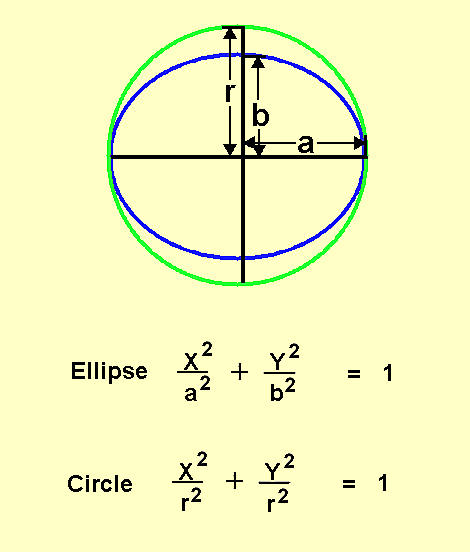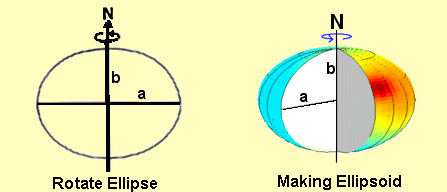




The rotation of the earth pushes out the equator. The true shape is that of an ellipse, rotated about its shorter axis. This is the line between the north and south poles. There are many ways to specify an ellipse. It takes two parameters. In geodesy, the most common ways are to:
An ellipse can be thought of as a flattened circle.

The two ellipse parameters, a and b, are shown in the figure. A circle that just encloses the ellipse, radius of "a", is also shown. This is called the circumscribing circle and is a useful construct in the mathematics of ellipses.
A common way to express the shape is to give the flattening constant, f. This specifies the shape. It is the relative difference between the lengths of the two axes,
or
Less common in geodesy, is using the eccentricity,e. This also specifies the shape, but uses the ratio of the squares of a and b.
To form a solid from the ellipse, it is rotated about the shorter axis. This axis is oriented along the polar axis. These models are called “Ellipsoids” or sometimes “Spheroids”.

The flattening of the real earth is 1/298.25. The same rotational effect also causes other planets to be flattened. The most extreme case is Jupiter. It has a radius about 10 times that of the earth and rotates in just 10 hours. Its flattening is 1/15. This can be seen in good photographs of Jupiter.
The earth could be modeled as a solid with three independent parameters. This is more complex and not necessary. A vast amount of data was used to generate a three-parameter ellipsoid, but the two radii in the equatorial plane differed by less than 10 m.
If the earth were a fluid which does not compress and is held together by gravity, the earth would be an ellipsoid with a flattening of 1/244. The density can be a function of the distance from the center in this analysis. The fact that the flattening is slightly smaller means that the earth is stiffer than a fluid, but just a little.
|
|
||||
|
|
|
|
|
|